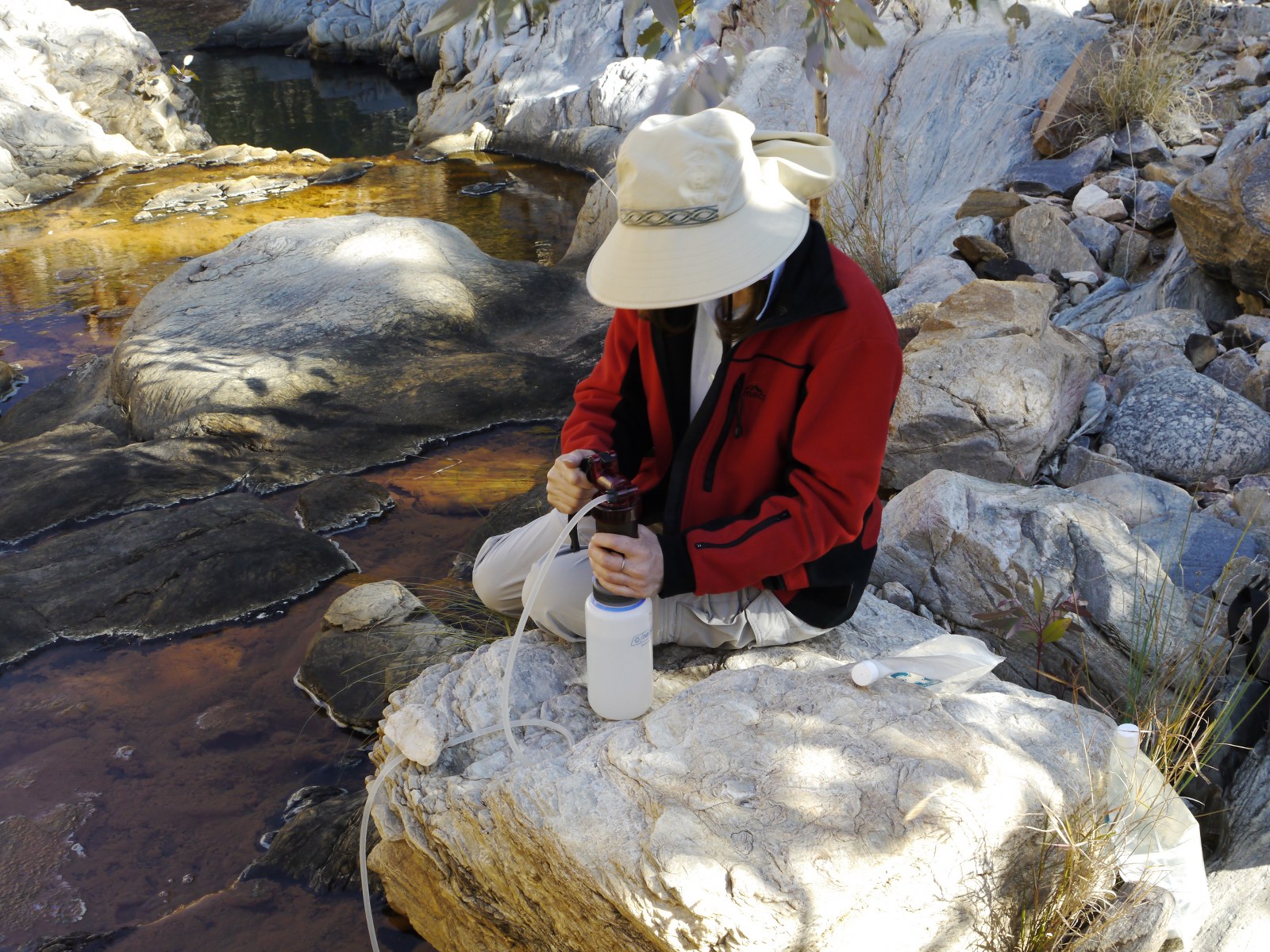There are several ways of treating water for drinking and cooking. Some treatment methods are more effective for specific types of contamination. Some water treatment devices combine treatment methods. No single method mitigates all hazards.
A filter can be lost, batteries can flatten or the device can be damaged. If going into an area where water quality may be dubious, consider taking more than one water treatment method.
Choosing a water treatment option
There are a variety of portable water treatment devices available. Consider the following before purchasing:
- possible contaminants in areas to be visited
- ease of use and time taken for water to be drinkable
- Individual or group use
- specifications
- initial purchase price
- weight of the product and attachments, if any
- lifespan of the filter, availability/cost of replacement parts or consumables
Boiling
Advantages
- Heat kills many pathogens, after a rolling boil of one minute.
- Allow to stand after boiling, until any sediment settles to the bottom. Clear water can be gently poured off.
Disadvantages
- Boiling releases toxins from blue green algae, which are not destroyed.
- Requires extra stove fuel.
- Requires water bottles suitable for hot water, eg aluminium.
Filtration
There is no single filter system that deals effectively with every type of contaminant. Each has advantages and disadvantages.
Filtration by itself is of benefit against pathogens such as giardia and cryptosporidium, of some benefit against bacteria, but not all systems remove viruses, as they are much smaller than the pores in many filters.
After filtering, chemical treatments can be used or water can be boiled to deal with pathogens (except blue green algae toxins) not removed by filtering alone.
Most filters have an internal element or cartridge which requires cleaning after a certain amount of use and is usually replaceable.
Filter types
- Pre-filters are used for removing particles such as leaf matter, soil or silt from water before it passes through the main filter. This step helps to maintain flow rates and reduces cleaning and replacement of filter cartridges. It improves the effectiveness of chemical treatments and is essential prior to using a UV purifier when water is murky or contains coarser solids.
- Simple pre-filters or screens, such as a clean handkerchief or cloth, remove some suspended materials, but have no effect against other contaminants. Better versions can be made using commercial nylon mesh used for example by field biologists to collect algae samples. Screens made from these materials are quick to use, and easy to clean and dry afterwards. Fine fabrics such as silk or polyester lining fabric can also be used. The screen can be incorporated into the top of a funnel to more easily direct the water into a container.
- Commercial pre-filters (5 µm) are used to remove the bulk of suspended solids and reduce the loading on finer pump or gravity filters.
- Squeeze bottle filters are light, and are quick and easy to use. The quantity filtered is limited by the size of the bottle or bag. These are good for individual use.
- Press bottle filters are bulky and weighty. They function by pressing down on the cylinder containing the filter. These filters remove almost everything including some chemicals and heavy metals.
- Pump filters use mechanical pressure in combination with a cartridge. The pore size is very small. Some have an activated-charcoal or ceramic core, while others use hollow fibre polymers. Some have pores small enough to exclude viruses. Pressure is provided by a hand-operated pump and takes time. Their weight and bulk is greater than some other filters.
- Gravity filters are the easiest way to treat large quantities of water, but take time. They are a good option for large groups or base camps. A suitable place is needed to suspend the water reservoir.
- Straw-type filters are designed for one-person use. They are compact and lightweight. Water is sucked up through a fine filter for immediate drinking from a water source. Particulates and pathogens, like bacteria and protozoa (Giardia and Cryptosporidium), are removed, but not viruses.
Filter cartridges
Cartridges form the core of water filters.
- Hollow fibre cartridges consist of hundreds of tiny tubes bundled tightly together. Each tube has microscopic pores which are too small for most pathogens to fit through. They are lighter than ceramic cartridges.
- Activated-carbon cartridges absorb many chemicals, including chlorine. They tend to block rapidly – prefiltration can reduce this.
- Ceramic cartridges rely on small pore size to remove dirt and pathogens, except viruses.
- Electroabsorption and activated carbon cartridges filter and purify water at the same time. They remove almost everything including some chemicals and heavy metals.
Purification by UV light
Ultraviolet (UV) light from UV purifiers is a practical option for water purification. UV light is effective in disrupting pathogen reproduction to make them far less harmful. They are most effective when the water is mixed during treatment and even more effective if two treatments are applied. Batteries are rechargeable.
Advantages
- Easy to use and water is quickly made safe to drink.
- No cleaning of cartridges.
- No added chemicals.
Disadvantages
- Time taken to treat sufficient water for a group if only one device is carried.
- Suspended materials in water impacts effectiveness – prefiltering is required.
- Does not remove sediments.
- A water bladder needs to be topped up from a bottle.
- The bulb is fragile.
- Ineffective in destroying blue-green algal toxins as the radiation intensity of the UV in these devices is insufficient.
Iodine-based tablets and drops
Iodine-based tablets and drops can treat some common pathogens including giardia and E. coli.
However, iodine is not effective against blue-green algae (as it does not neutralise the toxins) or cryptosporidium.
Water treated with Iodine-based tablets or drops has a strong salty, chemical taste. To counteract the taste use neutralising tablets (supplied with some products) or add drink flavour after treatment. Cool water should be treated then left to stand for at least 30 minutes before drinking.
Cold or murky water should be left for at least one hour before drinking.
Chlorine dioxide tablets and drops
Chlorine dioxide tablets and drops can be effectively used to disinfect drinking water without much alteration of palatability. They are lightweight and easy to use. The advantage over iodine-based products is the ability to also kill cryptosporidium.
Depending on the product, treatment times vary between 30 minutes and four hours.

